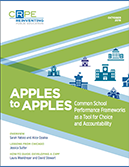Many districts are expanding and diversifying the school options available to parents—a trend that shows no signs of reversing. While all public schools are required to test and publically report results, it remains nearly impossible for families and education and civic leaders to make school-to-school comparisons, especially across district-run and charter public schools. To address the need for parents to have reliable performance information across school type, and/or for districts and charter authorizers to hold schools accountable to the same set of measures, some cities are developing unified accountability systems. This paper focuses on developing a common school performance framework (CSPF), a tool for measuring performance of an individual school using a defined set of metrics that is common to schools across different agencies or governing bodies.
Overview
What are the motivations for creating a CSPF, and why is it important to develop diverse and strong buy-in from key stakeholders? This overview draws on examples of cities who have effectively developed CSPFs, such as Los Angeles and Denver.
Lessons From Chicago
In 2013, Chicago Public Schools developed a CSPF, called the School Quality Rating Policy. Under this system, all schools—neighborhood, magnet, charter, selective enrollment, and special option schools—are rated based on a standard set of metrics. Chicago’s experience serves as a case study and offers “pearls of wisdom” for other cities looking to implement their own CSPFs.

How-To Guide
Ready to get started? This how-to guide outlines the major steps and key considerations a city should take into account when designing a CSPF.







